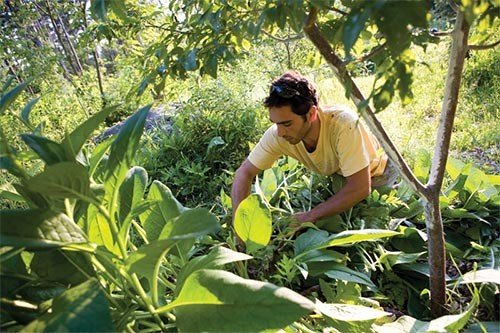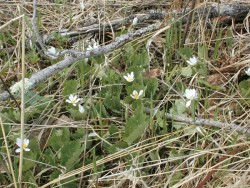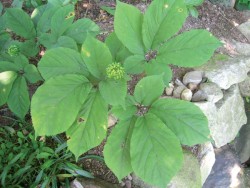In the spring of 1780, Jonathan Carpenter and his cousin set out from their home in southern Massachusetts to start a new life in Pomfret, Vermont. On May 13, they bought 100 acres of land, and two days later, Carpenter recorded in his diary, “…we began to chop and made the first stump on our land.” On May 20, he wrote this celebratory poem:
On our wild farm we’ve work’d a week
have built a house that’s Strong and Neat
and it will Serve, tho’ it is low
for kitchen, hall and Palace too –
planted Potatoes corn and beans
which some may take for foolish schemes
For Carpenter and his contemporaries, who broke the way into the “wilderness,” these wild farms were the first crude step toward transforming the northern forest into the homestead and village patchwork that already existed in southern New England. Today, modern “settlers” are reinventing the idea of the wild farm, blurring the boundaries between field and forest, agriculture and forestry, sanctuary and harvest. Instead of seeing the forest as an impediment to gardening, they’re tailoring their practices to complement a wild site. Some are cultivating valuable understory herbs and plants on the forest floor; others are using native plants to rehabilitate forest settings that have been compromised by poor management or invasive exotics. Still others are actively turning open land back into forest and forest edge, carefully designing plant groupings that can both produce crops and add forest structure. A few are even growing their own supply of firewood in raised beds.
As a result, woodland gardens dot the landscape, producing food, medicine, and fuel while suggesting 21st-century responses to the age-old settler’s question: how can this landscape sustain me? And as threats of climate change cloud long-range plans, these people and their latter-day homesteads answer with practical optimism.
Farming in the Forest
American ginseng, traded with Asia for over 300 years, was one of North America’s earliest exports. While early explorers and collectors scoured the forest for wild material, modern-day herbalists practice a more agricultural approach. Jeff Carpenter and Melanie Slick-Carpenter (no relation to the pioneer, Jonathan) grow ginseng and other native medicinal herbs under a forest canopy at Zack Woods Herb Farm in Hyde Park, Vermont.
Six years ago, the Carpenters thinned softwoods out of a hardwood forest on their farm. They used the timber to build a pole barn and then transformed the remaining red maple grove into a wild simulated herb garden by simply raking the forest floor humus into low raised beds. Now, goldenseal, bloodroot, and wild ginger, with an occasional American ginseng, grow in dense mats under the existing canopy, with little maintenance required from their human stewards.
Jeff Carpenter reports that these native woodland plants are not heavy feeders like the “potatoes, corn, and beans” planted by that other, 18th century, Carpenter. He hasn’t noticed any decline in the fertility of the soil in the six years he’s cultivated woodland plants. Carpenter doesn’t have to weed or fertilize the woodland beds, as the overstory trees provide deep enough shade and the plants create a dense, shallow, rhizomatous root mat, and are covered with maple leaves each fall. At harvest time, the entire bed, whose dense root mat is largely in the humus layer, is literally rolled up like a carpet.
Carpenter encourages other landowners to try this woodland gardening technique at home; the most important elements are well-drained soil and a hardwood overstory, preferably with rich-site trees like sugar maple and with plants spaced 8–10 inches apart. Carpenter also suggests keeping an eye on deer, which he suspects are a major cause of ginseng decline in the wild. His observation-based speculation is backed up by published research (see “Deer Love Ginseng to Death” in the Summer 2005 issue of Northern Woodlands). As a hedge against deer, woodland gardens could be fenced to deter white-tailed visitors.
The Carpenters got most of their original plant rootstock from a supplier friend in Ohio. Jeff recognizes concerns about bringing plant material, even from a native plant, from outside the region, but has had trouble locating seed and rootstock closer to home.
“Since there is so little wild goldenseal left in Vermont, I would certainly prefer that folks plant a root that comes from Ohio rather than not planting one at all,” said Carpenter. “Basically, I feel that we are part of a natural process similar to the way migrating birds can disperse seeds hundreds of miles away from their native growing areas.”
Now that the beds are established, Carpenter saves his own seeds for future plantings. He selects seeds preferentially from the top-quality specimens – those with higher amounts of essential oils or aromatics. He also collects seeds from wild populations and integrates them into the planting mix.
The couple’s efforts are paying off; they can’t keep enough medicinal herbs growing to satisfy their customers. In addition to the woodland beds, the farm also features 12 acres of open grown perennial herbs. Though most of their business is in dried and fresh herbs for herbal medicine manufacturers, their live plant business is also growing, particularly in native plants that are considered threatened by state and federal authorities. Planting threatened medicinal herbs for harvest is a bit like raising rare heritage turkeys for Thanksgiving dinner: the seemingly paradoxical practice increases the profile and value of the species, thereby lessening the probability that it will quietly disappear.
Turning Lemons into Lemon Verbena
Native plants are reappearing on Donna Wood Eaton’s property in Harwich, Massachusetts, located in the inland central part of Cape Cod. By the time Jonathan Carpenter left southern Massachusetts in 1790, the forests of the Cape were virtually nonexistent, and residents were importing firewood by ship from Maine. Trees later returned to the sandy soil as farmers moved west, but the forest wasn’t the same one that had been removed. Many understory plants take an extraordinarily long time to reestablish, even after the trees return. Yet on Wood Eaton’s “medicine trail” through wetlands and pine-oak uplands, visitors can now see some of the herbaceous plant diversity that has been lost from most woodlands in the region.
Wood Eaton, an herbalist and commercial herb grower, conceived of the medicine trail to heal a wound on her land. In 2000, she discovered that a developer working adjacent to her property had illegally clearcut part of her cedar swamp. Wanting to avoid a costly and unpleasant legal battle with her neighbor, she took responsibility for its restoration. The process soon turned positive, however, when she decided to use the situation as an opportunity to “utilize, protect, and get some enjoyment from” the cedar swamp and a neighboring vernal pool, integrating them more fully into the life of her 7-acre farm. Wood Eaton developed and implemented a restoration plan for the site beginning in 2001, with help from the Harwich Conservation Commission, the Harwich Conservation Trust, the Harwich Cultural Council, the Massachusetts Cultural Council, the New England Wildflower Society’s Garden in the Woods, and United Plant Savers, a nonprofit that works with landowners to develop woodland botanical sanctuaries for medicinal plant species it considers “at risk.” In addition to mapping and building the trail, removing some invasive species, and amending her woodland beds with topsoil and organic matter for three seasons, she researched herbaceous species that could have occupied the site before the Cape’s large-scale land clearing and settlement.

Wood Eaton wanted her woodland garden to be a sort of living museum that mimics the natural habitats of many of the herbs she grows in her production gardens. On her medicine trail, the plants are carefully planted in arrangements designed to show nature’s ideal patterns. Black cohosh is less shade tolerant than other species, so it grows in a small sunny patch while its large leaves shade bloodroot, a spring-flowering perennial that grows in shade during most of the growing season. Other species in the woodland garden include maidenhair fern, blue cohosh, red trillium, and yellow lady’s slipper. Blue flag iris and sweet flag grow in the wetter hollows of the site, and a few species that probably wouldn’t have naturally grown in the dry, sandy forests of the Cape, such as ginseng and goldthread, are nevertheless succeeding with the light tending that Wood Eaton now provides. Small signs give each plant’s name in English, Latin, and Braille.
The medicine trail is open to the public and dedicated to Wood Eaton’s grandmother, Marion Clockedile, a woman who lived to be 100 years old and who initially inspired her granddaughter to get out in the woods. Donna says that people often return from the walk very moved, never having experienced a forest and wetland in quite the same way before. She says of the restoration project, “When we finally put it all together, we had so many local and state agencies and organizations involved that they could put out the word and reach a whole lot more people. It helped to broaden awareness of the land and the plants, and bring a wider audience here to see it.”
The Edge Is Where the Action Is
The Carpenters, Donna Wood Eaton, and others who live and work in the woods know that the edge between forest and garden is not distinct, either physically or conceptually. The line is easily blurred. For Ben Falk, a landscape architect with a special interest in permaculture, the literal edge between field and forest holds tremendous possibility for cultivating highly productive, diverse, edible landscapes.
Falk’s 10 acre property on Dean’s Mountain in Moretown, Vermont, was formerly a hill farm that was “hammered” by clearcuts and multiple generations of dairy cows. A stand of white pines that began life after the wave of farm abandonment in the mid-20th century grows thickly to the south of Falk’s house. In many ways, the forest is returning. Yet Falk is not merely letting nature take its course; rather, he is “steering and accelerating succession” through thinning the pines and planting nut trees along his forested boundaries. In one sloping section along a southwest-facing forest edge, he’s planted American hybrid chestnut and black walnut saplings, as well as a Siberian nut pine, in the shelter of existing trees. These are upslope from more diminutive Montmorency cherry trees and a currant-gooseberry cross called a jostaberry (Ribes x hybrids; Falk chooses Ribes strains that do not harbor white pine blister rust). In the mulch under the shrubs grow bountiful crops of proteinrich winecap stropharia mushrooms, which build soil and at the same time provide food and cash for Falk.
Falk designed this “shelterbelt” arrangement of increasingly lower-growing plants (and mushrooms) to buffer winds, maximize sunlight, and trap warm air. The resulting conditions will help each plant or fungus thrive and produce maximally. With successively decreasing plant heights, each “layer” has both top and side exposed to the sun.
Growing Firewood?
In another section of his property, Falk explains his “firewood crop” of black locust and alder trees. While loggers may think of firewood as what the mill won’t buy, and do-it-yourself woodcutters often look for trees to cull from their properties, Falk has intentionally planted locust and alder in mounds along the slope’s contour to meet the future “caloric need of the woodstove.” Black locust is one of the densest and most rot-resistant fuel woods out there – according to some old sages, it “lasts a year less than granite.” Alder, on the other hand, has a BTU heating value similar to that of black cherry, not particularly high as hardwoods go, but the species is a fast grower. Besides this, Falk also values these species as nitrogen fixers. After only two years of growing in this well-drained arrangement, the trees are taller than a person and already beginning to form a sort of living fence.
Falk intends to manage this fuel supply by cutting “arm-thick” round wood and then letting the plants grow back with multiple stems (in horticultural circles this is called “coppicing,” when plants are cut at ground level, and “pollarding” when the cut is several feet above ground on major stems). “From early growth on test sites, it is likely that we will be able to begin harvesting pole wood and fuelwood in four to seven years,” he says. “At this point, the harvest rotation would begin. We would be able to harvest again from the same trees in a smaller interval in the future – probably after another two to four years, and again, perpetually, coppicing and pollarding the trees in rotation.”
Falk’s fuel garden was inspired in part by Europe’s long traditions of coppicing and pollarding, practices seldom seen in the U.S. Black locust has seen many uses over the years, and may prove to be the perfect tree for this job. Introduced from the southeastern U.S. beginning in the 1700s, it grew first in New England dooryards and was crafted into fenceposts and other farm necessities. Later, it became part of the Soil Conservation Service’s strategy to stem soil erosion on worn-out hill farms and riverbanks. [Editor’s note: black locust is considered invasive in some parts of the Northeast. Introduction of this species to your land is not without ecological risk.] Mature locusts tend to be plagued by insect pests, something Falk’s approach, in which stems never get too big or too old, may avoid.
Like everything on this property, the fuelwood “garden” has multiple purposes. Black locust has abundant sweet flowers prized by beekeepers as nectar sources; Falk notes that “arguably, there are few bee fodder crops as valuable” as this tree species. The blossoms are also desirable by humans; Falk describes them as “incredibly tasty and nutritious when the flowers first emerge in the spring – both cooked and raw.”
As anyone who has ever tried to keep abandoned pastureland open knows, most land in the Northeast just wants to be a forest. Jeff and Melanie Carpenter, Donna Wood Eaton, Ben Falk, and many others recognize this reality and are working with it by managing wooded land on a small scale, finding the potential of native understory herbs, fruit-bearing shrubs, and fast-growing trees to help make a living, clear the mind, feed people and animals, and keep a home warm in winter. Their woodland gardens result from the same careful planning, hard work, and practical ingenuity that their agricultural forebears, like Jonathan Carpenter over two centuries earlier, bequeathed. Like a managed timber stand or a sugarbush, these landscapes bear testament to the transformation nature of human hands.
Photo Gallery
Herbalists throughout the Northern Forest region value many native plants for their supposed medicinal properties. Below are some of the historic and reported medicinal properties of plants grown in the woodland gardens described in this article.
Sources of this information include Charlotte Erichsen-Brown’s Medicinal and other uses of North American plants: A historical survey with special reference to the Eastern Indian tribes, and Phyllis A. and James F. Balch’s Prescription for nutritional healing. Some plant medicines are very powerful and can be dangerous if used inappropriately. Harvest methods and the part of the plant used are important in medicinal preparations. There is no consensus in the medical community on the effectiveness of medicinal herbs. Northern Woodlands encourages readers to use this chart for informational purposes only.













Discussion *